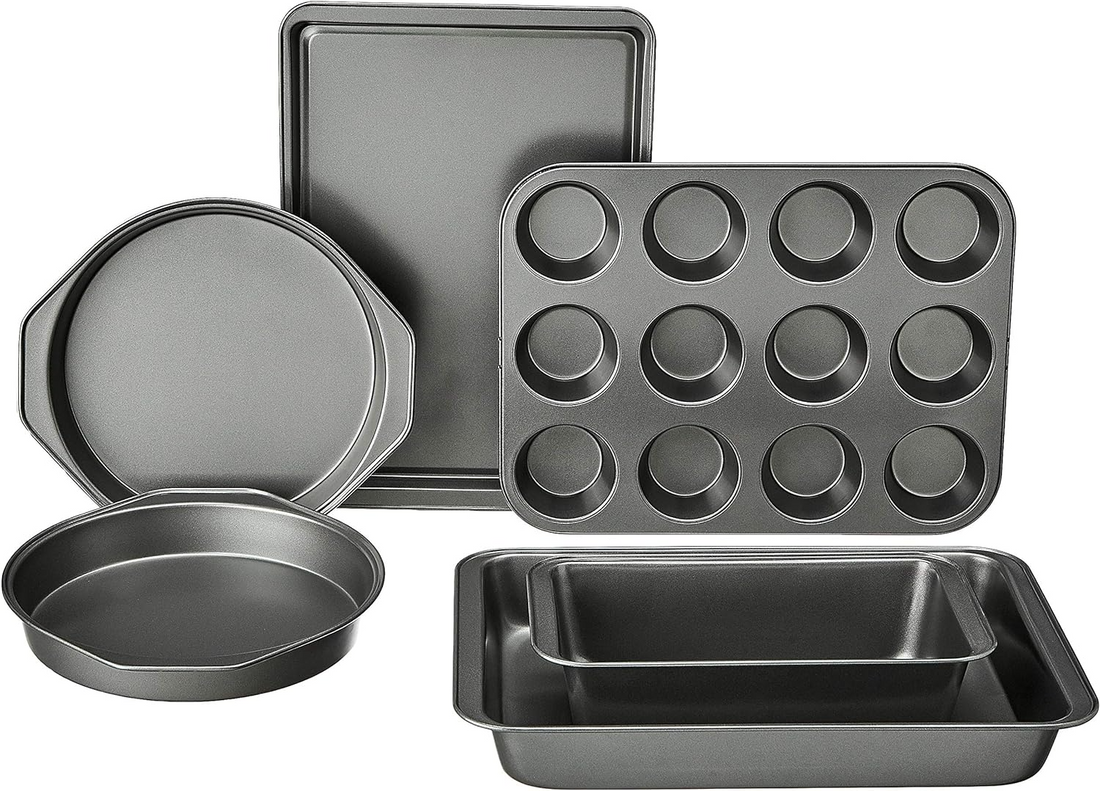The Ultimate Guide to Baking Tins: Choosing the Right Pan for Perfect Results

Share
The Ultimate Guide to Baking Tins: Sizes, Shapes, Materials, and Uses
In Grandmother’s Kitchen, baking tins are more than just tools—they’re the key to creating perfect baked goods. The right tin can ensure even baking, beautiful presentations, and delicious results. With various sizes, shapes, and materials available, choosing the correct baking tin can make all the difference. This guide will help you navigate the world of baking tins, offering insights on the best options for your baking needs.
Common Shapes and Sizes of Baking Tins
Round Cake Pans
Round cake pans are a staple in baking, commonly used for layer cakes, cheesecakes, and tortes. These pans range in diameter from 6 to 10 inches.
Personal Tip: Always line the bottom of the pan with parchment paper to ensure easy release of the cake.
Square and Rectangular Cake Pans
Square pans (8x8 inches) and rectangular pans (9x13 inches) are versatile for brownies, bar cookies, and single-layer cakes. They also work well for casseroles and savory dishes.
Personal Tip: Use an oven thermometer to ensure accurate baking temperatures and avoid uneven baking.
Loaf Pans
Typically sized at 9x5 inches, loaf pans are ideal for bread, pound cakes, and even meatloaf. They provide structure, making baked goods easy to slice.
Personal Tip: Grease and flour the pan, or use parchment paper, to prevent sticking and ensure easy removal.
Bundt Pans
Bundt pans, ranging from 6 to 12 cups, are known for their decorative designs and even baking. These are perfect for bundt cakes and coffee cakes.
Personal Tip: Thoroughly grease and flour every crevice to prevent sticking, especially in intricate designs.
Muffin Pans
Available in standard, mini, and jumbo sizes, muffin pans are perfect for cupcakes, muffins, and mini quiches.
Personal Tip: Use paper liners for an easy cleanup and a professional-looking presentation.
Springform Pans
Springform pans are best for cheesecakes and tortes, with sizes ranging from 8 to 10 inches. The removable sides allow for easy release of delicate desserts.
Personal Tip: Wrap the bottom of the pan with foil to prevent leaks when using water baths.
Tart and Quiche Pans
Typically sized between 8 to 12 inches in diameter, tart pans feature fluted edges that create decorative crusts.
Personal Tip: Use a tart ring to easily remove the tart from the pan without damaging its structure.
Jelly Roll Pans
Jelly roll pans, sized at 10x15 inches or 12x17 inches, are versatile for sponge cakes, sheet cakes, and roasting vegetables.
Personal Tip: Line with parchment paper for easy release and effortless cleanup.
Specialty Shaped Pans
These pans come in unique shapes like hearts, stars, and seasonal designs, perfect for themed cakes and special occasions.
Personal Tip: Use non-stick spray with flour to ensure intricate designs release smoothly.
Materials Used in Baking Tins
Aluminum
Aluminum is lightweight, rust-resistant, and offers excellent heat conductivity.
Personal Tip: Opt for anodized aluminum to prevent reactions with acidic foods like lemon or tomato.
Stainless Steel
Stainless steel is durable, resistant to rust, and doesn’t react with food. However, it may not distribute heat as well as aluminum.
Personal Tip: Choose stainless steel pans with an aluminum core for even heat distribution.
Non-Stick Coated Metal
Non-stick coatings provide easy release and simple cleanup but can wear off over time.
Personal Tip: Use silicone or wooden utensils to avoid scratching the non-stick surface.
Silicone
Silicone is flexible, allowing for easy removal of baked goods. It’s dishwasher safe but may require a baking sheet for stability.
Personal Tip: Ensure the silicone is food-grade and BPA-free for safety.
Glass
Glass offers even baking and doesn’t react with food. It also provides an attractive presentation but can be heavier and prone to breaking.
Personal Tip: Avoid drastic temperature changes to prevent glass from cracking.
Ceramic
Ceramic pans are visually appealing and distribute heat evenly. However, they can be heavy and expensive.
Personal Tip: Use a ceramic pan with a non-stick glaze to make cleaning easier and prevent sticking.
Choosing the Right Baking Tin for Your Recipe
When selecting a baking tin, keep the following factors in mind:
- Recipe Requirements: Certain recipes may call for specific shapes or sizes, like a springform pan for cheesecakes.
- Material Preferences: Consider the pros and cons of each material based on your baking style.
- Maintenance and Durability: Choose a tin that’s easy to clean and will last through years of baking.
- Even Baking: Ensure your tin distributes heat evenly to avoid hot spots and uneven cooking.
- Storage Space: Larger pans or specialty shapes may require extra space in your kitchen.
By understanding the various types of baking tins, you can make informed choices for your baking projects. Whether you're whipping up a cake, baking a loaf of bread, or preparing muffins, selecting the right tin is key to achieving delicious results every time. With the proper care, your baking tins will last for years, helping you create countless delicious treats in Grandmother’s Kitchen.


